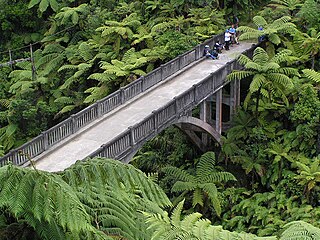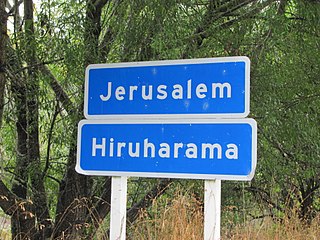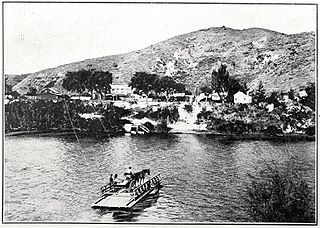 W
WThe Whanganui River is a major river in the North Island of New Zealand. It is the country's third-longest river, and has special status owing to its importance to the region's Māori people. In March 2017 it became the world's second natural resource to be given its own legal identity, with the rights, duties and liabilities of a legal person. The Whanganui Treaty settlement brought the longest-running litigation in New Zealand history to an end.
 W
WĀtene is a former village located 35 kilometres (22 mi) up the Whanganui River from Whanganui. Originally called Warepakoko, then Kakata, it was renamed by the missionary Richard Taylor in the 19th century as a Māori transliteration of Athens. It was the home of the hapū Ngāti Hineoneone of the iwi Te Āti Haunui-a-Pāpārangi. A small meeting house called Te Rangi-i-heke-iho, restored by carver Bill Ranginui, is all that remains.
 W
WThe Bridge to Nowhere is a concrete road bridge spanning the Mangapurua Stream in Whanganui National Park, North Island, New Zealand. It has no roads leading to it, but it is a popular tourist attraction, accessible by mountain bike or tramping on a variety of different tracks, or by boat or kayak, followed by a 45-minute walk along maintained bush trails.
 W
WJerusalem, named for the Biblical Jerusalem, is a settlement 66 kilometres (41 mi) up the Whanganui River from Whanganui, New Zealand. Originally called Patiarero, it was one of the largest settlements on the Whanganui River in the 1840s, with several hundred Ngāti Hau inhabitants of the iwi Te Āti Haunui-a-Pāpārangi. Unlike other Whanganui River settlements given transliterated place names by Reverend Richard Taylor in the 1850s, Jerusalem is usually referred to using the English version of its name. It grew into several small settlements, including Roma (Rome) and Peterehama (Bethlehem), founded by the remains of Taylor's congregation after the majority converted to Catholicism when a Roman Catholic mission was built in 1854.
 W
WKaiwhaiki is a settlement 18 kilometres (11 mi) upriver from Whanganui, New Zealand.
 W
WKoriniti is a settlement 47 kilometres (29 mi) upriver from Whanganui, New Zealand, home to the Ngāti Pāmoana hapū of the iwi Te Āti Haunui-a-Pāpārangi.
 W
WMoutoa Island is an island of shingle approximately 500 metres (1,600 ft) long, 80 kilometres (50 mi) up the Whanganui River, New Zealand between the towns of Rānana and Hiruharama.
 W
WParikino is a settlement 24 kilometres (15 mi) upriver from Whanganui, New Zealand; the original pā site was across the Whanganui River.
 W
WRanana is a settlement 60 kilometres (37 mi) up the Whanganui River from Whanganui, New Zealand.
 W
WTieke Kāinga is a small Māori community in New Zealand, on the middle reaches of the Whanganui River 2.5 kilometres (1.6 mi) downstream from the mouth of the Mangatiti Stream. It is centred on Tieke Marae, a converted Department of Conservation tramping hut. The surrounding land is subject to a Māori land claim which began with occupation of the hut in 1993.
 W
WUpokongaro or Ūpokongaro is a settlement 12 kilometres (7.5 mi) upriver from Whanganui, New Zealand, in the Makirikiri Valley. Settled by Europeans in the 1860s, it was an important ferry crossing and riverboat stop. A spectacular discovery of moa bones was made in the area in the 1930s.
 W
WThe PS Waimarie is a historic riverboat based on the Whanganui River in New Zealand.
 W
WWhanganui, also spelled Wanganui, is a city in the Manawatū-Whanganui region of New Zealand. The city is located on the west coast of the North Island at the mouth of the Whanganui River, New Zealand's longest navigable waterway. Whanganui is the 19th most-populous urban area in New Zealand and the second-most-populous in Manawatū-Whanganui, with a population of 42,200 as of June 2020.